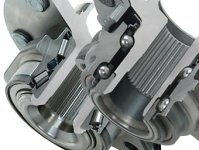Failed bearing is a funny concept. Wear-out failure can allow the tone ring to just move away from the abs sensor. You might see some strangeness in the wheel speed sensor return signal. Of course you won't know it until your dash does the "Christmas Tree" thing. Then you buy an ABS module, and a real time data acquisition module for your OBD2 port. I bought the Bluetooth enabled BlueDriver module. Then I drove around with a laptop on the console. Eventually I caught the missing wheel speed pulse count, and replaced the single speed sensor, only to find the Unit Bearing to have some slop, but no other symptoms. (no death wobble, no shimmy, no tire wear, no nothing...) And it wasn't easy to feel, with the brake caliper installed. Once I removed the caliper, and re-installed the wheel, I could feel the looseness. Changed the Speed Sensor and symptoms went away. Then replaced the Unit bearing. I forgot about that one. Google "Jeep Wrangler Christmas Tree Dash"
This is the insidious nature of the Unit Bearing. They cause other problems long before they fail enough for the wheel to fall off. Not so much a problem in the front end, because there is a U-joint out on the end to allow for angular misalignment. But not so in the rear end. I encourage anyone that kneels at the Altar of the Unit Bearing to some research on the 2021+ F150 with Tow Package Rear 3/4 float axle RECALL. (Google recall 23s65) This is a textbook example of why you don't use unit bearings in anything that carries a load.
https://www.ford.com/support/how-to...150-2021-2023-rear-axle-bolt-breakage-recall/ This design cannot be saved, and there is no resolution. Ford only hopes that your warranty expires before your truck quits. Because the problem is intrinsic to the design.
But yes, if you are lucky enough to get to drive your unit bearing long enough to have it actually expire, it might allow the tone ring to grind off the head of the ABS sensor. And the sensor that comes with the replacement bearing has a less then 50% chance of actually fitting your application. The pigtail length, pinout configuration, and little plastic thingys to hold in in place are usually wrong. So you end up using your old one. But yeah, it makes it more expensive.
Lastly, I don't know how you folks in the rust belt manage your unit bearing service. I've had to do a couple of East Coast XJ Dana 30 hubs from the 90's and the rust and corrosion attack the unit bearing bolt heads (which are way too small) and the unit bearing will seize in the hub bore. There are some tricks to use your power steering to help get them out but I've often been relegated to brute force. Dumbest design ever.
Once again, I do understand that they have a place and time. And if you ONLY need to transmit torque, and you can de-rate your load by 70% like
@Yeller (~1500 lbs on a 4900 lb axle) It might get you across the finish line. But planned obsolescence drives me bananas.
So yeah, I'm a hater.












